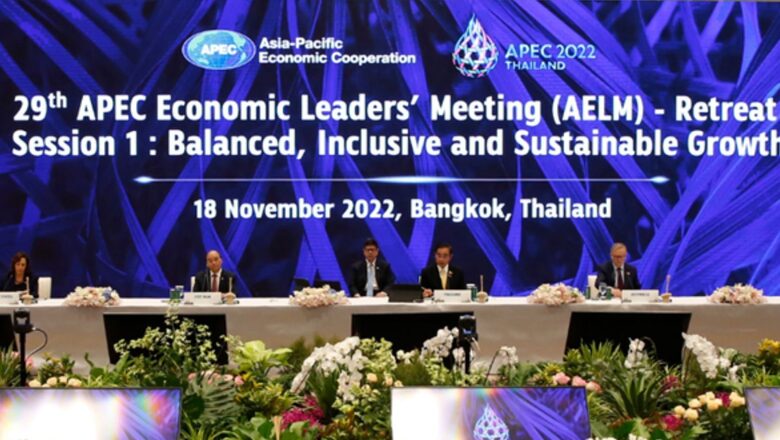
views
The APEC Summit held in Bangkok on November 18-19 rounded off the series of ASEAN, EAS in Cambodia and G20 Summit in Indonesia in the week preceding APEC. It brought much attention to ASEAN countries. It was the first physical summit in four years.
APEC is a 21-member body which covers North and South America and the ASEAN and East Asian countries. It consists of member economies rather than States to accommodate Taiwan and Hong Kong, which China acquiesced since 1991. Besides seven ASEAN countries, it has Australia, New Zealand, China, Japan and Korea, all of which are part of the Regional Comprehensive Economic Partnership (RCEP). Russia, Papua New Guinea, Taiwan and Hong Kong and from the Americas it has the USA, Canada, Mexico, Peru and Chile are also part of APEC.
APEC has its own secretariat in Singapore and different procedures. It is not an ASEAN-centric body. It is currently chaired by Thailand and was preceded by New Zealand, Malaysia and Papua New Guinea and will be followed by the USA as the host in 2023 followed by Peru, 2024 and Korea in 2025.
All summits vie to get the largest participation of leaders. Of particular interest are leaders of the big powers. That is why summits often try to create a chain of dates, so leaders, particularly from distant continents, come to one region and attend summit after summit in succession. Thailand was happy that their main partners, China, Japan and Korea, were represented by President Xi, PMs Kishida and Han Duck-Soo. Of the seven ASEAN members in APEC, six were represented at the highest level, except Malaysia, which was having a general election. The president of Chile, the Vice-President of Peru, Australian, Canadian, Papua New Guinea and New Zealand Prime Ministers all participated.
Mexico sent its local Ambassador, while Hong Kong was represented by its chief executive, John Lee Ka-Chiu and Taiwan by the founder of the semiconductor giant, TSMC, Morris Chang.
President Biden who was there for EAS and G20 returned to Washington for a family wedding and vice-president Kamala Harris stood in for him. She took over the APERC Presidency from Thai PM Prayuth. Russia, which was represented by Foreign Minister Lavrov at EAS and G20, was now represented by first deputy prime minister Andrei Belousov, with President Putin once again missing the summit. Thailand also invited French President Macron and Saudi Arabian Crown Prince Mohammed bin Salman. It was a de-freezing of Thailand’s ties with Saudi Arabia and acknowledging the French larger interest in the Indo-Pacific as a close partner
Its main aim is to be an economic forum of the region to support sustainable economic growth and prosperity. Thailand aimed to pursue the Free Trade Area of the Asia Pacific (FTAAP). The Ukraine and Taiwan crisis and the US initiative for IPEF and China and Taiwan vying to join CPTPP diminished the importance of the FTAAP. Of the 14 members of IPEF, 11 are in APEC. All 11 members of CPTPP are in APEC.
The implementation of the APEC Putrajaya Vision 2040, including through the Aotearoa Plan of Action, remains in vogue. This year, under the APEC theme ‘Open. Connect. Balance’, three priorities — to be open to all opportunities, connected in all dimensions, and balanced in all aspects — were sought “to advance long-term robust, innovative and inclusive economic growth as well as sustainability objectives in the Asia-Pacific region”. On Ukraine, the APEC Leaders Declaration followed the G20 pattern.
Greater trade, better competitiveness in services sector, Enhanced APEC Agenda for Structural Reform (EAASR), APEC Business Travel Card (ABTC), APEC Connectivity Blueprint (2015-2025), digital transformation, Bangkok Goals on the Bio-Circular-Green (BCG) Economy and SDGs remain essential attributes of APEC focus. Most emerged from Sectoral Ministerial Meetings for trade, tourism, health, forestry, food security, women and the economy, small and medium enterprises, and finance in 2022.
India never joined APEC despite initial enthusiasm when it was launched in 1989. India was not seen as an open economy in 1989, but after India’s positive role in the EAS, Indonesia, the Chair of APEC in 2013, attempted to invite India, but was dissuaded by China. In 1998, Peru, Russia and Vietnam joined, after which an embargo was placed. Although it ended in 2010, consensus on India or other new members is lacking.
In 2015, several endorsements for India’s APEC membership emerged. The USA through a US-India Joint Strategic Vision for the Asia-Pacific and Indian Ocean Region in January, Japan at the Annual Summit in December, and Russia and China in the RIC in February 2015 welcomed India’s association with APEC. Seven years later, it remains unrealised.
In 2016, when PM Modi visited the USA, the joint statement recalled the Indo- Pacific cooperation, but there was no mention of the APEC. The same was noted in the Trump-Modi meeting in June 2017, by when the attention was more on the strategic aspects of the Indo-Pacific. With Japan, the APEC position was maintained for the next two years, but in 2018, the reference to APEC was dropped from the Joint statement.
The Russia, India China (RIC) Communiqués retained the ‘welcome to APEC’ sentence for two further years, but when RIC met after a hiatus in 2019, the line was dropped due to divergence of views on the Indo-Pacific.
It is clear that as India’s participation in a more determined way in the Indo- Pacific increased and its interest in RCEP diminished, its perceived interest in APEC, as well as opposition from China in particular, dominated. APEC is not a strategic concept but an economic one and does not appear to fit in with the Indian thinking, which has largely remained inconsistent on associating with it. As India is now not part of RCEP, but is in the IPEF, it is unlikely to join the effort for the new FTAAP. India also does not seem to have ambitions towards FTAs in the region thus leaving associating with APEC’s FTAAP out of current plans.
The APEC ministerial meetings through the year were divided on Ukraine and none could issue a consensual conclusion. The Ministerial meeting on the eve of the summit had the G20 template, which India had facilitated, and thus a consensual Leaders Statement finally ensued. Even an economic body like APEC was hopelessly cleaved by the Ukraine crisis and remained silent on Taiwan.
The COP 27 taking place simultaneously also lowered attention on it. The rise of the Indo-Pacific and the rival CPTPP and now IPEF diminish the APEC and it trundles along as another institution which must fulfil its annual engagements.
The writer is a former Indian ambassador to Germany, Indonesia, Ethiopia, ASEAN and the African Union, chair of the CII task force on trilateral cooperation in Africa, and a professor at IIT Indore.
Read all the Latest Opinions here

















Comments
0 comment